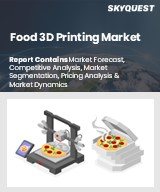
세계의 식품 3D 프린팅 시장 규모는 2023년에 6억 350만 달러로 평가되었으며, 예측 기간(2025-2032년) 동안 CAGR 50.1%로 성장하여 2024년 9억 585만 달러에서 2032년에는 233억 4,014만 달러로 성장할 전망입니다.
세계 식품 3D 프린팅 시장은 맞춤형 영양, 지속가능한 식품 생산, 혁신적인 요리 경험에 대한 수요 증가에 힘입어 크게 성장하고 있습니다. 소비자들은 독특한 식단 선택을 원하고 있으며, 특정 영양 프로필을 가진 맞춤형 식품을 만들기 위해 3D 프린팅을 활용하고 있습니다. 이 기술은 또한 음식물 쓰레기를 줄이고 대체 단백질 공급원을 찾는 데 도움이 되어 다양한 식생활의 요구를 충족시킬 수 있습니다. 고급 레스토랑부터 가정용 주방까지 다양한 용도에 특화된 프린터와 식재료가 등장하고 있습니다. 경쟁 상황에는 기존 식품 기술 기업과 새로운 신생 기업이 있으며, 주요 기업은 하드웨어와 요리 레시피의 발전에 집중하고 있습니다. 식품 기업과 3D 프린팅 기업의 협업은 맞춤형 과자에서 식물성 대체육에 이르기까지 상업적 응용을 강화하고 있습니다.
Global Food 3D Printing Market size was valued at USD 603.5 million in 2023 and is poised to grow from USD 905.85 million in 2024 to USD 23340.14 million by 2032, growing at a CAGR of 50.1% during the forecast period (2025-2032).
The global food 3D printing market is experiencing significant growth fueled by the increasing demand for personalized nutrition, sustainable food production, and innovative culinary experiences. Consumers are seeking unique dining options, prompting the use of 3D printing to create customized food with specific nutritional profiles. This technology also aids in reducing food waste and exploring alternative protein sources, catering to diverse dietary needs. A variety of specialized printers and ingredients are emerging for applications ranging from high-end restaurants to home kitchens. The competitive landscape features established food technology companies and new startups, with key players concentrated on advancing their hardware and culinary recipes. Collaborations between food companies and 3D printing firms are enhancing commercial applications, from customized confections to plant-based meat alternatives.
Top-down and bottom-up approaches were used to estimate and validate the size of the Global Food 3D Printing market and to estimate the size of various other dependent submarkets. The research methodology used to estimate the market size includes the following details: The key players in the market were identified through secondary research, and their market shares in the respective regions were determined through primary and secondary research. This entire procedure includes the study of the annual and financial reports of the top market players and extensive interviews for key insights from industry leaders such as CEOs, VPs, directors, and marketing executives. All percentage shares split, and breakdowns were determined using secondary sources and verified through Primary sources. All possible parameters that affect the markets covered in this research study have been accounted for, viewed in extensive detail, verified through primary research, and analyzed to get the final quantitative and qualitative data.
Global Food 3D Printing Market Segments Analysis
Global Food 3D Printing Market is segmented by Component, Technology, Ingredients, Application, End Use and region. Based on Component, the market is segmented into Hardware, Software and Services. Based on Technology, the market is segmented into Extrusion-based Printing, Fused Deposition Modeling, Sintering and Binder Jetting. Based on Ingredients, the market is segmented into Dough, Fruits & Vegetables, Proteins, Sauces, Dairy Products and Carbohydrates. Based on Application, the market is segmented into Personal Consumption, Commercial Food Production, Food Decoration and Nutritional Customization. Based on End Use, the market is segmented into Retail Stores, Bakeries, Confectionaries, Restaurants and Residential. Based on region, the market is segmented into North America, Europe, Asia Pacific, Latin America and Middle East & Africa.
Driver of the Global Food 3D Printing Market
The rising demand for customized food products catering to various health-related needs and dietary restrictions, such as gluten intolerance, vegan preferences, and specific nutritional requirements, is driving the expansion of the Global Food 3D Printing market. This innovative technology allows for precise control over both the ingredients and nutrient content, enabling the production of tailored meals that meet individual dietary preferences and health goals. Moreover, 3D food printing facilitates the creation of personalized functional foods, enhancing the ability to address diverse consumer needs and preferences in a way that conventional food manufacturing cannot.
Restraints in the Global Food 3D Printing Market
The Global Food 3D Printing market faces significant limitations, primarily due to the high costs associated with industrial-grade equipment, which remain prohibitive for many small to medium-sized enterprises. The expense of specialized food-grade cartridges and printable ingredients is notably higher than that of conventional raw materials, making it challenging for these businesses to adopt this technology on a commercial or residential scale. As a result, the financial barriers deter widespread adoption, hindering innovation and limiting access for smaller operations that could otherwise benefit from advancements in food 3D printing. This poses a considerable challenge to the market's overall growth potential.
Market Trends of the Global Food 3D Printing Market
The Global Food 3D Printing market is experiencing a significant shift towards personalized and functional foods, propelled by the increasing consumer demand for tailored nutrition solutions. Advancements in technology have facilitated the precise control of nutrients, calories, and ingredients, allowing for the creation of customized food products that cater to individual health needs, dietary preferences, and allergies. This innovative approach is particularly beneficial for specialized diets, such as those for athletes, seniors, or individuals with unique medical conditions. As the emphasis on customization and health intensifies, the food 3D printing market is poised to transform traditional food production and consumption patterns.